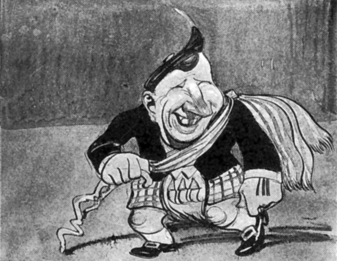Prime Minister, Gordon Brown, is aiming to follow the advice of music hall hero Sir Harry Lauder, it appears.
In his hit 'Keep Right On To The End Of The Road, the Edinburgh born comic singer urged his listeners: 'Tho' you're tired and weary, still journey on'.
Now the PM has hinted at his determination to stay in office by telling Dundee schoolchildren the tune is his all time favourite.
He said the classic, written after SDir Harry's son was killed in World War I, meant a lot to him because of its connection with military history.
What the Prime Minister did not tell the schoolchildren of Dundee was that Sir Harry Lauder (1870 - 1950) was a Freemason and an ardent one at that. Below we provide a brief outline of Brother Lauder's life and Masonic career (Ed.)
LAUDER, Sir Harry (1870 - 1950)Initiated into Freemasonry in Lodge Dramatic, No. 571 (Glasgow). Born in Bridge Street, Portobello few miles east of Edinburgh. He was the son of a potter, with the surname MacLennan. As a boy he worked 12 hour shifts in a flax mill in Arbroath and as a teenager worked as a pitboy then coalminer for 10 years in Hamilton.
A visit to a circus in Abroath gave him the first insight to show business and his success in a singing contest convinced him that this was to be his destiny. Early success in Scotland and then England led to his first tour of the United States of America. 25 tours followed eventually typically earning earning $5000 a week and playing golf with presidents.
His affection for his wife, Annie (whose given name may actually have been Nancy) Vallance (1873/4–1927), daughter of a Hamilton coalminer, gave rise to two of his most successful songs; ‘Roamin in the Gloaming’ and ‘I Love a Lassie’. His son, John, was killed in action during World War I and that inspired him to write the song; ’Keep Right on to the End of the Road’.
Henry Canova Vollum. Morton (1892 – 1979), a journalist and writer, met him in Aberdeen during 1928 and described him as 'small, sturdy and smooth of face. He wore hexagonal glasses and smoked a six inch briar pipe. His Glengarry was worn at a jaunty angle and, as he walked, the almost ankle-length Inverness cape which he wore exposed a bit of a MacLeod kilt. The superior person will perhaps sniff if I suggest that no man since Sir Walter Scott* (1771 – 1832) has warmed the world's heart to Scotland more surely that Sir Harry Lauder. His genius is a thing apart'.
His reputation has suffered from those who criticise him for creating the sterotype of a kilted, ultra-thrifty Scot.
The greatest tribute to him must be that his songs are sung every day somewhere in the world. Brother Lauder's fame extended far beyond his native country and although he played golf with American Presidents (he toured the USA 25 times in all such was his popularity) he never forgot his humble Scottish origins nor that he was a Freemason.

In the latter years of his life especially, he would often arrive, unannounced at a Lodge, and happily entertained the Brethren during the Harmony following the meeting.
He represents a classic example of a working class Scot who became a Freemason long before he became famous. His is therefore much in the mold of Brother Robert Burns* (1759 - 1769.)
For every famous individual like Brother Lauder there are and were 10,000’s of other working class Scots who obtained the same pleasure as did he from Freemasonry. The last word should be his;
'Aye, I'm tellin' ye... happiness is one of the few things in this world that doubles every time you share it with someone else'.
*Sir Walter Scott and Robert Burns were also Freemasons (Ed.)
